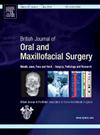Open management of condylar head fractures. The first 50 cases: What have we learnt and where are we going?
IF 1.7
4区 医学
Q3 DENTISTRY, ORAL SURGERY & MEDICINE
British Journal of Oral & Maxillofacial Surgery
Pub Date : 2025-01-01
DOI:10.1016/j.bjoms.2024.08.005
引用次数: 0
Abstract
This study evaluates a single surgeon’s experience in the development of a practice in open treatment of intracapsular condylar fractures over three years at a tertiary maxillofacial trauma centre. An enhanced dynamic, peer-reviewed, longitudinal audit in keeping with the adoption of elements of new clinical practice was instituted. This aimed to record and analyse clinical and functional outcomes at both the surgeon and patient level. A retrospective review of patients treated for AO craniomaxillofacial (AOCMF)-classified intracapsular fractures was conducted, utilising an extended preauricular approach and positional screw fixation with an emphasis on early joint mobilisation and physiotherapy. The cohort consisted of 45 patients with 50 fractures, exhibiting a mean postoperative mouth opening of 32 mm, which increased over time and was noted to be statistically significant. Patient satisfaction was high, and the majority of radiological outcomes were deemed anatomical. No patients had permanent facial nerve injuries. Other postoperative complications were minimal, including one case of Frey syndrome and a 16% re-intervention rate, primarily for hardware removal. The findings suggest that open treatment can achieve satisfactory early function as part of the implementation of an in-part novel procedure. This paper provides insight into the establishment of a new technique in both experiential and governance domains, and looks at the lessons learned. The high levels of patient and surgeon satisfaction confirm increasing levels of evidence supporting open reduction and fixation in these challenging injuries, but the study’s limitations include the absence of a control group and potential non- generalisability due to the single-surgeon perspective. The study highlights the need to support colleagues providing this treatment and establish a national mentoring programme to achieve it. At this point, long-term studies and a multicentre trial are suggested for a comprehensive understanding of the treatment’s efficacy and the formal development of management protocols.
髁状突头部骨折的开放性治疗。前 50 个病例:我们学到了什么,我们将何去何从?
本研究评估了一家三级颌面创伤中心的一名外科医生三年来在髁突内骨折开放性治疗方面的实践发展经验。为配合新临床实践要素的采用,该中心开展了一项强化的动态、经同行评审的纵向审计。其目的是记录和分析外科医生和患者的临床和功能结果。我们对接受过AO颅颌面(AOCMF)分类囊内骨折治疗的患者进行了回顾性审核,采用了扩大耳前入路和定位螺钉固定,并强调早期关节活动和理疗。45名患者共50处骨折,术后平均张口度为32毫米,随着时间的推移,张口度逐渐增加,并具有统计学意义。患者的满意度很高,大多数放射学结果被认为是解剖学上的。没有患者出现永久性面神经损伤。其他术后并发症极少,包括一例 Frey 综合征和 16% 的再次介入率,主要用于硬件拆除。研究结果表明,作为部分新型手术的一部分,开放式治疗可以获得令人满意的早期功能。本文从经验和管理两个方面深入探讨了新技术的建立,并总结了经验教训。患者和外科医生的高满意度证实了越来越多的证据支持对这些具有挑战性的损伤进行开放复位和固定,但这项研究的局限性包括缺乏对照组,以及单一外科医生的视角可能导致的不普遍性。该研究强调,有必要为提供这种治疗方法的同事提供支持,并建立一个全国性的指导计划来实现这一目标。目前,建议进行长期研究和多中心试验,以全面了解该疗法的疗效,并正式制定管理方案。
本文章由计算机程序翻译,如有差异,请以英文原文为准。
求助全文
约1分钟内获得全文
求助全文
来源期刊
CiteScore
3.60
自引率
16.70%
发文量
256
审稿时长
6 months
期刊介绍:
Journal of the British Association of Oral and Maxillofacial Surgeons:
• Leading articles on all aspects of surgery in the oro-facial and head and neck region
• One of the largest circulations of any international journal in this field
• Dedicated to enhancing surgical expertise.

 求助内容:
求助内容: 应助结果提醒方式:
应助结果提醒方式:


